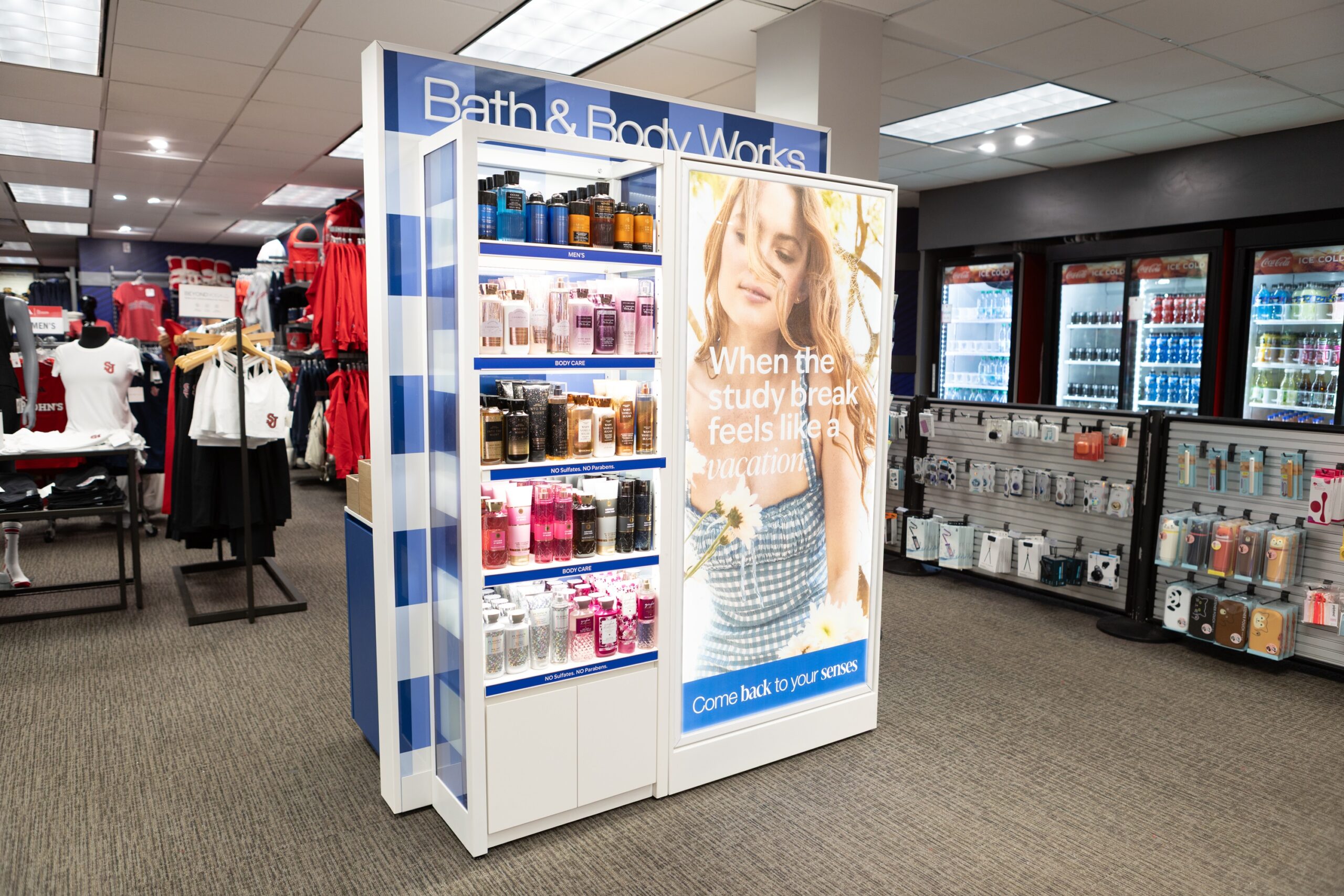
Image courtesy of Bath & Body Works
August 6, 2025
Does Bath & Body Works’ College Play Make Sense?
Bath & Body Works is making a play into something of a new market, packing its proverbial bags and heading to a college campus near you.
According to an August 6 press release shared by the retailer, Bath & Body Works will be selling its product lineup — from soaps and fragrances to candles and lotions — in more than 600 campus stores across the United States, just in time for the highly anticipated back-to-school season. Per Reuters, participating schools include George Washington University, Boston College, and Vanderbilt University, among others.
“It was important for Bath & Body Works to expand into college campuses as it allows us to reach our Gen Z customers where they are and when they need us most,” says Betsy Schumacher, chief merchandising officer for Bath & Body Works.
“By providing an easy and convenient way to shop the fragrances they know from a brand they love, we hope we can make their dorm rooms feel more like home,” she added.
The move is supported by bookstore operators such as Barnes & Noble and Follett Corp., as well as ICM Distributing Company Inc.
Continued Focus on Gen Z Seen as Key to Bath & Body Works’ Future Success Story
In remarks shared by Reuters, Bath & Body Works CEO Daniel Heaf indicated that generating interest — and sales — among Gen Z consumers was top-of-mind. Heaf, who took over helming the company earlier this year in May, has been focused on righting the ship following a difficult year for the retailer, as the company was removed from the S&P 500 index.
A couple of interesting statistics appear to make this pitch worthwhile for Bath & Body Works: First, the brand scored very highly on three key metrics via an April 2025 Piper Sandler “Taking Stock with Teens” survey — placing first in the fragrance brand category among all American teens, and also taking down third place as a beauty destination for in-store shopping and fifth for loyalty programs (per teen girls surveyed).
Second, the same survey found that, among the teen demographic, fragrance sales had surged by 22% against the year prior, making that first-place designation even more valuable.
Speaking to the matter of Gen Z’s centrality to this latest plan, Heaf said that the move into campuses represents “a way to keep the conversation going with teen girls while they’re… not living with their parents anymore, not going to their usual places anymore.”
The Importance of Third-Party Distribution, and the Potential ‘End’ of an Either / Or Proposition
And with Heaf having direct experience with company shifts toward DTC sales, having run Nike’s business operations on that score prior to joining Bath & Body Works, he pointedly suggested moving away from a move which appears to have backfired for his previous employer.
“This idea of being either a wholesale brand or a direct-to-consumer brand is over,” Heaf told Reuters, continuing to add that he believed third-party distribution to be more central to future growth.
Discussion Questions
How successful do you foresee the expansion of Bath & Body Works onto U.S. college campuses being? What unexpected payoffs / consequences could arise, in your opinion?
Is the “idea of being either a wholesale brand or a direct-to-consumer brand” over, as suggested by Heaf?
Poll
BrainTrust
David Biernbaum
Founder & President, David Biernbaum & Associates LLC
Georganne Bender
Principal, KIZER & BENDER Speaking
Neil Saunders
Managing Director, GlobalData
Recent Discussions








The rationale for this is very simple. College students buy candles for the dorms, and they buy body care. They are already core customers of Bath & Body Works. Putting small activations in college campuses will increase penetration and frequency. Bath & Body Works has solid margins, so this will easily pay for itself. The key will be editing down the selection so that it’s relevant and interesting.
For the off-campus market a bigger possibility. Or community college areas, where students are commuters.
But candles can be against “open flame” or smoke policy on campuses. Not just fire hazard, but a sensory problem for tight living quarters (hello, arguments). Many scented candles release chemicals and particles that can irritate/trigger asthma. The concept of a “bath” or spa atmosphere is also limited when on-campus.
I am filing this under the category of nit-picking. Students already buy these products and I am sure many use candles and body products while on campus. Yes, flames may be against some college policies, but so is underage drinking and we all know what happens there. Besides, there are always Wallflowers for those that wish to be strict!
L Brands ran the same play when introducing Pink for Victoria’s Secret, and at that time no one thought the college market would support a near-luxury brand. As BBW is more consumable-focused, I think it will do even better than its predecessor.
Plus, as all college students know, lighting a candle is far quicker than cleaning your dorm room!
I don’t see a downside here – unless they pour an ungodly amount of money into it – but how much potential there is I don’t know: it’s not exactly news that much brand identification begins around the college years, and while choosing a new candle scent isn’t likely to be at forefront of many self-discoveries, the timing certainly makes sense.
As for the either-or of distribution, I think we”ll see more blending – i.e. omnichannel – than in the past, but I don’t see some quantum change: there are distinct advantages and disadvantages for each mode, and they aren’t both right for everyone.
While the expansion of Bath & Body Works could introduce the brand to a younger demographic, there may be challenges in appealing to college students’ budgets and preferences.
Students look for affordability and convenience, so pricing strategies and product selection will be crucial.
Additionally, Bath & Body Works might face competition from local stores and online shopping options that students frequently use.
A solution could be implemented by the brand in the form of student discounts or loyalty programs that offer special deals for students.
Another approach would be to offer bundled products for a lower price, thereby allowing more people to access popular items.
It would also be beneficial for the brand to implement a flexible pricing model that caters specifically to the needs of students, such as limited-time promotions during peak shopping periods.
Bath & Body Works’ college expansion is a brilliant strategy for preserving existing relationships through life transitions. BBW already dominates teen preferences (first in fragrance among American teens), but risks losing customers when they leave home and familiar shopping routines. CEO Heaf’s insight into keeping “the conversation going with teen girls while they’re not living with their parents anymore” reveals a sophisticated approach to customer lifecycle management that addresses churn caused by convenience and routine disruptions.
Learning from Target’s campus format success and avoiding American Apparel’s overexpansion failures, BBW leverages existing bookstore infrastructure to test scalability across 600 locations. They’re ensuring teenage brand loyalty persists into adulthood while providing the appropriate emotional connection that fosters comfort and familiarity away from home. As for distribution models, there’s no either/or; future retail success requires being channel-agnostic with a focus on the many ways of achieving customer convenience rather than short-term margin optimization.
Fragrances and skincare and candles and college campuses… What’s there to talk about? Bath & Body Works is a brand Gen Z already knows and loves, this is a smart move.
If I were the marketing guru at BBW, I wouldn’t really care about the volume. To me, the number one objective is to solidify the brand with these soon-to-be graduates as they seek their adventures in life,
College bookstores have changed dramatically since I was a student buying stone tablets and chisels. Today’s college bookstores, with co-branding relationships, can drive more revenue for the bookstore while offering brands a chance to connect with students as they develop their independent relationships. For Bath & Body, this is an excellent opportunity to reach this market. The students are able to do more on campus. For kids in dorms, especially 1st and 2nd year students who might not have a car on campus, or who are new to an area, access to these brands close to home.I see this as an easy win for Bath & Body.
Wasn’t the question of being EITHER a wholesale brand OR direct to consumer answered a couple of decades ago? Sure, there was a time when retailers didn’t want any competition from brands being DTC. And that was before ecomm was even a concept. I remember when Polo Ralph Lauren opened their store in the Rhinelander mansion many years ago. Bloomingdale’s was horrified…horrified. Until it was quickly obvious that that magnificent store very much reinforced and elevated the brand perception and worked in Bloomingdale’s favor as well. It’s all about the quality of the execution, and brands are highly incentivised to set the whole tone for their brand with their DTC initiatives.
Bath & Body Works isn’t waiting for students to come to them – they’re meeting Gen Z right where they are. With fragrance sales on the rise and strong brand loyalty among teens, the timing makes a lot of sense. It goes to show that relevance and convenience can be just as important as the product itself.